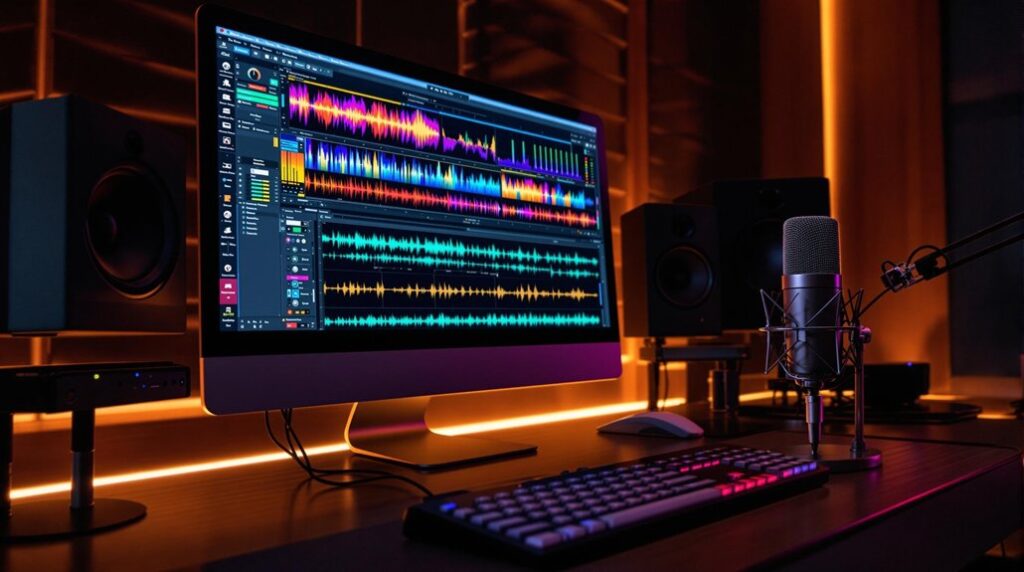The Pro Tools versions differ greatly in track count capacity, simultaneous recording inputs, and plugin and effects availability. Track capacity ranges from 8 audio tracks in Pro Tools Intro to a maximum of 2048 in Pro Tools Ultimate, catering to varying project complexities. Recording inputs vary from 4 in Intro to 512 in Ultimate, supporting everything from basic setups to expansive productions. Plugin availability and auxiliary track support increase with each version, evolving to AAX plugins for stability and efficiency. Each features specific design optimizations for targeted users, with options tailored for beginners to high-stakes professionals exploring advanced audio production.
Key Takeaways
- Track count capacity varies from 8 to 2048 audio tracks across different Pro Tools versions.
- Simultaneous recording inputs range from 4 to 512 depending on the Pro Tools version.
- Plugin and effects availability increase with each version, from limited to comprehensive bundles.
- Each Pro Tools version targets different user levels, from beginners to professional audio producers.
- Workflow enhancements like Quick Punch and AAX plugins improve efficiency in higher-tier versions.
Track Count Capacity
The track count capacity in Pro Tools versions varies considerably, catering to different levels of audio production needs.
Pro Tools Intro provides a foundational setup with support for 8 audio tracks, making it suitable for simpler projects.
As users progress to Pro Tools Artist, the track count capacity expands to 32 audio tracks, offering more flexibility for intermediate productions.
For advanced users, Pro Tools Studio extends the capability to 64 audio tracks, accommodating more complex sessions.
At the pinnacle, Pro Tools Ultimate delivers an extensive track count capacity of up to 2048 audio tracks, ensuring the highest level of professional audio production.
Each version of Pro Tools is designed to meet specific demands, allowing users to scale their projects accordingly. Users can also implement Quick Punch for seamless overdubs and punch-ins, enhancing workflow efficiency in larger projects.
Simultaneous Recording Inputs
Building upon the track count capacity, simultaneous recording inputs serve as another pivotal aspect of Pro Tools' versatility, tailoring to diverse recording environments.
Pro Tools Intro makes sure newcomers can efficiently manage up to 4 tracks, ideal for simple configurations.
Meanwhile, Pro Tools Artist caters to musicians and hobbyists, supporting up to 16 inputs, thereby offering enhanced flexibility for more sophisticated compositions.
For those who might need a robust solution, Pro Tools Studio provides up to 64 simultaneous inputs, perfectly aligning with professional-grade projects.
Finally, Pro Tools Ultimate stands at the apex with an impressive 512-input capability, designed for advanced users engaged in expansive audio production and post-production tasks, ensuring no project is too demanding.
Optimal audio quality can be achieved by leveraging Pro Tools' ability to configure input paths and manage gain staging effectively, ensuring recordings are free from distortion and clipping.
Plugin and Effects Availability
Diverse plugin and effects availability in Pro Tools versions greatly influence the software's adaptability to various production needs. The evolution of features across versions caters to a broad spectrum of audio professionals, from novices to seasoned experts.
- Pro Tools Intro: Limited to one reverb and one delay plugin, this version is ideal for basic projects requiring minimal effects.
- Pro Tools Artist and Studio: With 32 and up to 1024 auxiliary tracks, respectively, these versions offer extensive routing for complex soundscapes, utilizing Avid audio enhancements and party plugins to enrich production quality.
- Pro Tools Ultimate: Equipped with a thorough plugin bundle, it empowers users with advanced sound design capabilities, making it indispensable for high-stakes post-production and intensive audio projects.
The transition to AAX in newer versions of Pro Tools has enhanced stability and efficiency, particularly in professional environments, by offering high-quality audio processing and seamless integration.
This tiered approach guarantees tailored solutions for diverse audio production requirements.
Frequently Asked Questions
What's New in Pro Tools 2024.3 1?
Pro Tools 2024.3 introduces new features enhancing audio editing capabilities, including advanced track freezing and improved MIDI tools. The updated user interface offers refined usability, facilitating streamlined navigation and efficient access to essential tools, aligning with current industry standards.
What Versions of Pro Tools Are There?
Pro Tools offers four versions: Intro (free), Artist ($9.99/month), Studio ($34.99/month), and Ultimate ($599/year). Each version varies in Pro Tools features, track limits, and Pro Tools pricing, catering to different audio production needs.
What Is the Difference Between Pro Tools Ultimate and Studio?
Pro Tools Ultimate features extensive track and input capacities with advanced routing and plugin support, tailored for high-demand audio post-production. In contrast, Studio capabilities focus on musicians, offering a robust yet streamlined toolset for standard production environments.
Why Are Pro Tools Discontinued?
Pro Tools has not been discontinued; instead, it has undergone software evolution to better serve the diverse needs of audio production professionals, offering various versions like Intro, Artist, Studio, and Ultimate to enhance functionality and accessibility.
Conclusion
In summary, Pro Tools versions exhibit significant variations in track count capacity, simultaneous recording inputs, and plugin and effects availability. The differences in track count capacity determine the scale of projects that can be efficiently managed. Simultaneous recording inputs are vital for accommodating complex recording sessions. Plugin and effects availability influences the creative possibilities and sound manipulation capabilities. Understanding these distinctions is essential for selecting the appropriate Pro Tools version to meet specific production needs and optimize workflow efficiency.




